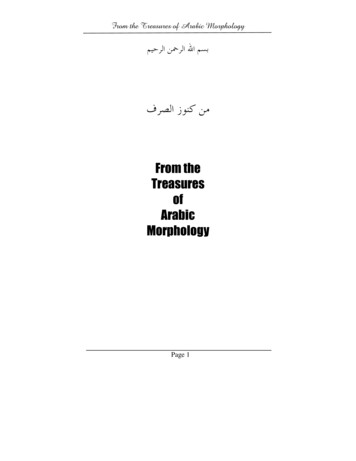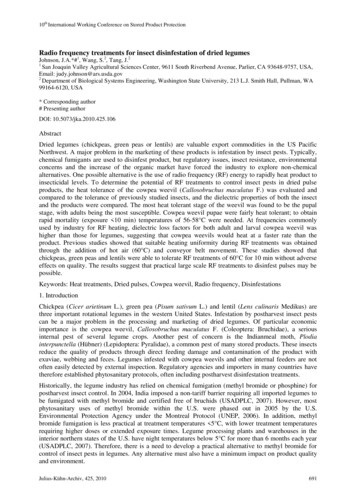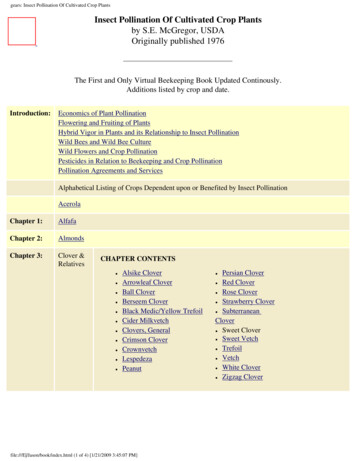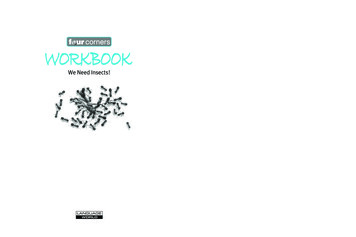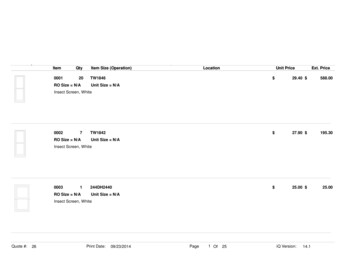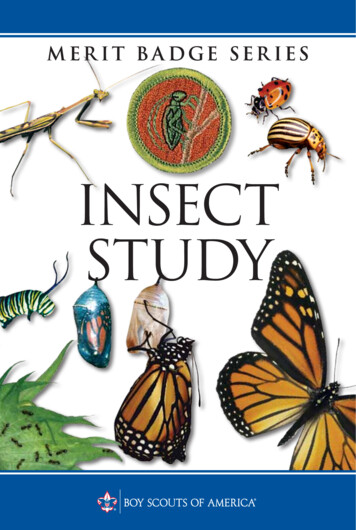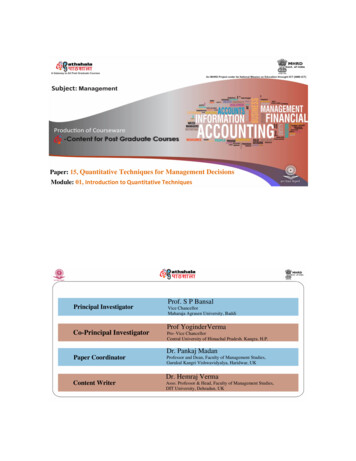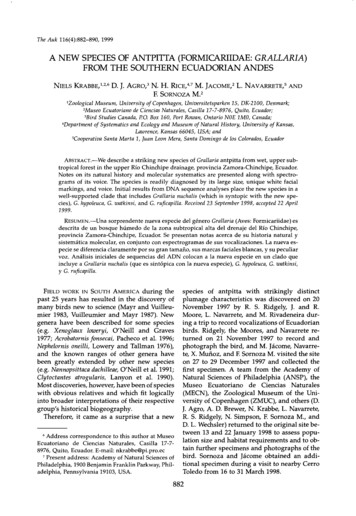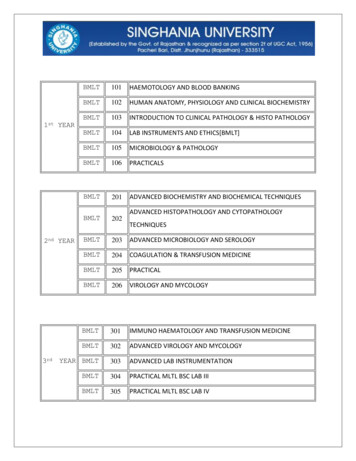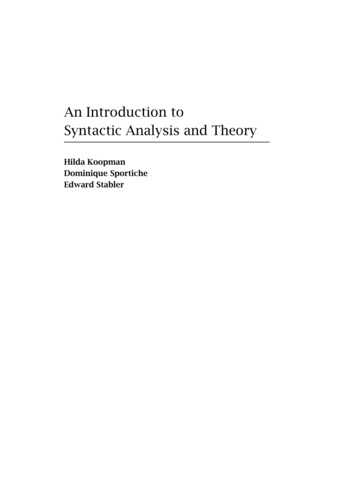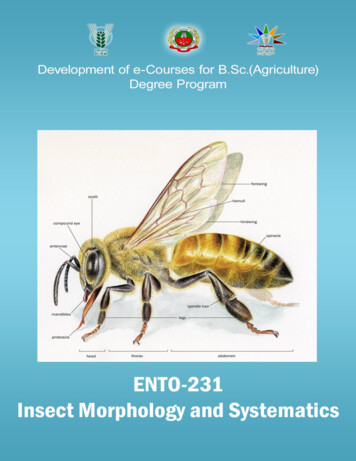
Transcription
Insect Morphology and SystematicsAuthorTNAU, Tamil Nadu
IndexLecture1. History of entomology in India and position of insects in animal2. Factors for insects abundance3. Classification of phylum Arthropoda upto classes. Relationship ofclass Insecta with other classes.4. Structure and functions of insect cuticle and moulting.5. Body segmentation. Structure and modifications of insectantennae, mouth parts and legs. Wing venation, modifications andwing coupling apparatus. Sensory organs.6. Metamorphosis and diapause in insects.7. Types of larvae and pupae.8. Structure and functions of digestive system.9. Circulatory10. Excretory11. Respiratory12. Nervous13. Reproductive systems in insects.14. Types of reproduction in insects.15. Taxonomy – importance, history and development and binomialnomenclature. Definitions of Biotype, Sub-species, Species, Genus,Family and Order.16. Classification of class Insecta upto Orders.17. Orthoptera-Acrididae18. Dictyoptera-Mantidae19. Odonata20. Isoptera-Termitidae21.Thysanoptera-Thripidae22. Hemiptera - Pentatomidae, Coreidae, Pyrrhocoridae, Lygaeidae,Cicadellidae, Delphacidae, Aphididae, Coccidae, Aleurodidae,Pseudococcidae23. Neuroptera-Chrysopidae24. idae,Page 114115-116117-117118-133134-136137-147
Cerambycidae,Curculionidae,Bruchidae, Scarabaeidae26.Hymenoptera-Tenthridinidae, Apidae, Trichogrammatidae,Ichneumonidae, Braconidae27. Diptera-Cecidomyiidae, Trypetidae, Tachinidae, Agromyziidae.148-161162-172173-181
Insect Morphology and SystematicsHISTORY OF ENTOMOLOGY IN INDIA AND POSITION OF INSECTS IN ANIMALKINGDOM AND ITS RELATIONSHIP WITH OTHER ARTHROPODAHistory of Entomology in India1758 - 10th edition of Systema Naturae Linnaeus with only 12 Indian insects which was theearliest record.1779 - Dr. J.G. Koenig - Medical Officer initiated the work on Indian insects on scientific lines.He also published a special account of the termites of Thanjavur District.1782 - Dr. Kerr Published on account of lac insect.1785 - Asiatic Society of Bengal started in Calcutta and many papers were published in theSocietys publications.1790 - Roxburgh (Botanist) published a detailed account of lac insect.1791 - Dr. J. Anderson issued a monograph on Cochineal scale insects1800 - Buchanan (Traveller) wrote on the cultivation of lac in India and on sericulture in someparts of South India. Denovan published Natural History of Insects which was the firstcontribution on the insects of Asia and was revised in 1842 by West Wood.1875 - Foundation of the Indian Museum at Calcutta1883 - Bombay Natural History Society was started. After the foundation of these twoorganisations scientific studies received greater attention in India. Numerous contributions ofIndian insects were published in the Journal of the Bombay Natural History.1892 - Hampson issued four volumes on months of India1893 - Rothney published on Indian Ants (earliest record of biological pest control in India) i.e.White ants attach on stationary items was kept free by red ants.Government of India commenced the publication of the Fauna of British India series5www.AgriMoon.Com
Insect Morphology and Systematics1897 - Bingham's issued volumes on "Hymenoptera' (Ants, bees and wasps). Since thanvolumes on other groups of insects like Coleoptera (beetles), Hemiptera (bugs), Odonata(dragenfly and damselfly), etc., were published.1889 - Indian Museum, Calcutta published the Indian Museum Notes in five volumes.1903 - which contributed much on economic entomology and applied entomology in India.19th Century marks the major progress and expansions in the field of applied entomology.1901 - (Lionel de Nicevelle) posting of the first entomologist to the Government of India.1905 - Establishment of Imperial Agricultural Research Institute at Pusa (Bihar). Subsequentlythis Institute was shifted to New Delhi as Indian Agricultural Research Institute.1906 - “Indian Insect Pests” & “Indian Insect Life”Books by Professor Maxwell. Lefroy, Head,Division of Entomology, IARI, New Delhi. Subsequently State Governments also took upentomological work.Madras, Punjab and Uthar Pradesh appointed their first GovernmentEntomologists in 1912, 1919 and 1922 respectively.1914 - T.B. Fletcher, the first Government Entomologist of Madras State, published his book"Some South Indian Insects".1916 - The Natural History Section of the Indian Museum was formed as the ZoologicalSurvey of India.1921 - Indian Central Cotton Committee to investigate on pests of cotton.1925 - Indian Lac Research Institute1940 - Dr. T.V. Ramakrishna Ayyar published the book "Handbook of Economic Entomology"which met the long felt need of the students of Agriculture and agricultural scientists as well.1968 - Dr. M.S. Mani's "General Entomology"1969 - Dr. H.s. Pruth's "Textbook of Agricultural Entomology". Dr. Pradhan's "Insect Pests ofCrops"6www.AgriMoon.Com
Insect Morphology and Systematics1946 - Government of India started the "Directorate of plant protection".1960 - "The Desert Locust in India" monograph by Y.R. Rao.1969 - "The monograph on Indian Thysanoptera" by Dr. T.N. Ananthakrishnan7www.AgriMoon.Com
Insect Morphology and SystematicsFACTORS FOR INSECTS ABUNDANCEMeasures of dominance1.More number of species: In the animal kingdom more than 85 per cent of the speciesbelongs to insect group. Total number of insects described so far is more than 9 lakhs.2.Large number of individuals in a single species:e.g., Locust swarm comprising of 109 number of individuals, occupying large area.3.Great variety of habitats: Insects thrive well under varied conditions.4.Long geological history: Insects were known to occupy this earth for more than 350 millionyears, which is a good track record. This has given the insects great variety of adoptionsunder different conditions.Reasons for dominance8www.AgriMoon.Com
Insect Morphology and Systematics1. Capacity for flight: Insects posess wings, which is the lateral extension of exoskeleton.Insects are the earliest animals and the only flying invertebrates. Flight is used for thefollowing purpose.i.To seek food, mate, shelter and oviposition sitesii.To colonize in a new habitat and also to exchange habitat.iii.To escape from enemies and unfavourable conditions.iv.To migrate (i.e. for long distance travel e.g. Locusts)2. Adaptability or Universality: Insects are the earliest groups to make their life on the earth andto occupy vast habitats of soil and water.i.Found in wide range of climatic conditions, from -50 C to 40 C.ii.Psilopa petroli found in crude petroleum well.iii.Ephydra fly living in great salt lake.iv.Every flowering plant providing food for one or many Phytophagous insects.v.Even the decomposing materials serving as food for many Saprophagous insects.vi.Many Carnivorous insects are parasitic on other animals and insects.3. Size: Majority of insects are small conferring the following physiological and ecologicaladvantages.i.Exploitation of numerous ecological niches inaccessible for other animals.ii.Less space, food, time and energy requirements for development and sustaining life.iii.Energy Utilization maximum.iv.Less gravitational effect.v.Muscular action and tracheal respiration more effective.vi.Easy escape from enemies.4. Exoskeleton: Insect body is covered with an outer cuticle called exoskeleton which is madeup of a cuticular protein called Chitin. This is light in weight and gives strength, rigidity andflexibility to the insect body.9www.AgriMoon.Com
Insect Morphology and SystematicsEXOSKELETON CROSS SECTIONUses: i.Act as external armourIi.Provides space for muscle attachmentIii.Prevents water loss5. Resistance to desiccation: Insects minimise the water loss from their body surface throughthe following processes.I.Prevention of water loss:i.Lipids and polyphenols present in the Epicuticle acts as water proofing.ii.Was layer with closely packed wax molecules prevents escape of water.iii.Spiracles are closed to prevent water loss.iv.In the egg stage shell development prevents water loss and desication of inner embryos.II. Conservation of wateri.Capable of utilizing metabolic waterii.Rectal resorption of water from faeces.iii.Terrestrial insects use less quantity of water to remove the nitrogenous waste (Uric acid)which is water insoluble.6. Tracheal system of respiration: This ensures direct transfer of adequate oxygen to activelybreathing tissues. Spiracles through their closing mechanism admit air and restrict water loss.10www.AgriMoon.Com
Insect Morphology and Systematics7. Reproductive potential: Reproductive potential of insect is high due to the following reasons:i Egg laying capacity (fecundity) is high. e.g., Queen termite lays 6000 - 7000 eggs per day for15 long years.ii. Development period is short. e.g., Corn aphid produces 16 nymphs per female which reachesthe adulthood within 16 days. There by one generation is completed within a short period of 16days, which favours greater genetic changes in the insect population, like quicker development ofinsecticide resistant strains.iii. Careful selection of egg lying sites and protection of eggs.iv. Exhibits parental care like progressive provisioning (e.g. bees) and mass provisioning (e.g.Wasps)v. Presence of special types of reproduction other than oviparity and viviparity.*Polyembryony: Development of many individuals from a single egg. e.g. parasitic wasps.*Parthenogenesis: Reproduction without male or without fertilization, e.g. aphids*Paedogenesis: Reproduction by immature stages. e.g. certain flies.8.Complete metamorphosis: More than 82 per cent of insects undergo completemetamorphosis (Holometabolous insects) with the following four stages.i.Egg: Inactive, inexpensive, inconspicuous and embryo develops inside.ii.Larva: Active, feeds, digests, grows and store food.iii.Pupa: Inactive, internal reorganisation and resist adverse conditions.iv.Adult: Active, reproduce and disperse11www.AgriMoon.Com
Insect Morphology and SystematicsAs the larval and adult food sources are different, competition for food is less.9. Defense mechanisms: By using the following defense mechanisms, insects escape from theenemies to increase their survival rate.i.Behavioural: Thanatosis - insects pretends as if dead. e.g. some beetles.ii.Structural e.g. hardened forewings of beetles known as elytra protect the beetles frompredation of birds.iii.Colourational: Presence of protective colours. e.g.Stick insectsiv.Chemical: Presence of defensive chemicals. e.g. Bees producing venom10.Hexapod locomotion: Insects uses 3 legs at a time during locomotion, while theremaining 3 legs are static, which gives greater stability.12www.AgriMoon.Com
Insect Morphology and SystematicsCLASSIFICATION OF PHYLUM ARTHROPODA UPTO CLASSES & POSITION OFINSECTS IN ANIMAL KINGDOM AND ITS RELATIONSHIP WITH OTHER ARTHROPODAInsects are invertebrates grouped in the phylum Arthropoda (Subphylum : Uniramia)Characters of the Phylum Arthropoda: (Arthro-joint, poda-foot)i.Segmented bodyii.Segments grouped into 2 or 3 regions known as Tagmosisiii.Renewable chitinous exoskeletoniv.Grow by moultingv.Bilateral symmetryvi.Body cavity filled with blood-Haemocoelvii.Tubular alimentary canal with mouth and anusviii.Dorsal heart with ostiaix.Dorsal brain with ventral nerve cordx.Striated musclesxi.No ciliaxii.Paired segmented appendagesClassification: 7 classes.Phylum : ArthropodaClasses :1.Onychophora (claw bearing)e.g. Peripatus2.Crustacea (Crusta - shell)e.g. Prawn, crab, wood louse3.Arachnida (Arachne - spider)e.g. Scorpion, spider, tick, mite4.Chilopoda (Chilo - lip; poda - appendage)e.g. Centipedes5.Diplopoda (Diplo - two; poda- - appendage)e.g. Millipede6.Trilobita (an extinct group)13www.AgriMoon.Com
Insect Morphology and Systematics7.Hexapoda or Insectae.g. Insects.POSITION OF INSECTS IN ANIMAL KINGDOM14www.AgriMoon.Com
Insect Morphology and SystematicsTable 1. Relationship of Insects with other hilopodaDiplopodaInsects (Hexapoda)1.TerrestrialAquatic andTerrestrialTerrestrialTerrestrialMany terrestrial andHabitfew terrestrial2.BodyNot distinctregionsvery few aquaticTwo-Three-Pro,Two-Head andTwo-Head andThree-Head, thoraxCephalothoraxmeso andmultisegmentedmultisegmentedand abdomenand abdomenMetasoma eg.trunktrunkNo antennaOne pairOne pairOne pairOne pair-One pair-simpleOne pair-simpleOne pair-simpleBoth simple eyes andStalkedeyeseyeseyescompound eyes (oneScorpion TwoPro andOpisthosomaeg. Spider3.Antenna1 pair2 pair Antennule andAntenna4.VisualNot distinctorganscompoundpair)eyes5.LocamotorMany pairs ofMinimum fiveorgansunjointed legsFour pairsOne pair perTwo pair perThree pairs of legs onpairs ofsegment (Firstsegment (Nothree thoracicbiramous legspair of legspoison claws)segments and two15modified aspairs of wings onpoison claws)meso and metathoraxwww.AgriMoon.Com
Insect Morphology and ibulateMandibulate - 1 pairpartsmandibulate(1 pair)mandibulate,- 1 pair- 1 pairTrachealTrachealTrachealbut possesschelicerae7.RespirationCutaneousGill breathingBook lungs(Scorpion) andtracheal(spiders)8.Body lymphHaemolymph9.CirculatoryHeart withHeart withHeart with ostiaHeart with ostiaHeart with ostiaHeart with -ntScorpion;Metamorphosispresent-mites11.HabitFeed onHerbivorus and Phytophagousorganic matterCarnivorousand predatorspredators andparasitoides12.SpecialLink betweenCalsificationLife cycle; Egg-Opisthogenital-Progogenital-Genital structures onfeaturesAnnelida andstrengthenslarva-numph-gonoporegonopore in 3rd8th and 9thArthropodaexoskeletonadult larva withpresent in thesegmentabdominal segments.3 paris of legsterminal16Brain with proto,www.AgriMoon.Com
Insect Morphology and Systematicsand Nymph with4 pairs of legs17segmentdeuto andtritocerebrumwww.AgriMoon.Com
Insect Morphology and SystematicsSTRUCTURE AND FUNCTIONS OF INSECT CUTICLE AND MOULTINGInsect body wall is called as Integument or Exoskeleton. It is the external covering of thebody which is ectodermal in origin. It is rigid, flexible, lighter, stronger and variously modified indifferent body parts to suit different modes of life.StructureBody wall consists of an inner cellular layer (Epidermis) and an outer non cellular part(Cuticle).EpidermisIt is an inner unicellular layer resting on basement membrane with the following function.i.Cuticle secretionii.Digestion and absorption of old cuticleiii.Wound repairingiv.Gives surface lookCuticleIt is an outer non cellular layer comprising of three sub layers.i. EndocuticleCompared to others it is the inner and thickest layer. This layer is made up of Chitin andarthropodin. This layer is colourless, soft and flexible.ii.ExocuticleOuter layer, much thicker with the composition of Chitin and sclerotin. This layer is darkin colour and rigid.iii.Epicuticle: Outer most layer which is very thin. Pore canals present in the exocuticlehelps in the deposition of epiculticle. This layer is differentiated into the following layers.a.Inner epicuticle: It contains wax filamentsb.Outer epicuticle: It makes the contact with cuticulin18www.AgriMoon.Com
Insect Morphology and Systematicsc.Cuticulin : Non chitinous polymerised lipoprotein layer.d.Wax layer: It contains closely packed wax molecules which prevents desiccation.e.Cement layer: Outer most layer formed by lipid and tanned protein. It protects wax layer.Composition of cuticlei.Chitin: It is the main constituent of cuticle, which is Nitrogenous polysacharide and polymer of Nacetylglucosamine. It is water insoluble but soluble in dilute acids, alkalies and organic solvents.ii.Arthropodin: An untanned cuticular protein, which is water soluble.iii.Sclerotin: Tanned cuticular protein, which is water insoluble.iv.Resilin: An elastic cuticular protein responsible for the flexibility of sclerites, e.g., wingarticulatory sclerites.ENDOSKELETONCuticular in growth of body wall providing space for muscle attachment is known asendoskeleton. There are two typesi.Apodeme: Hollow invagination of body wall.ii.Apophysis: Solid invagination of body wall.CUTICULAR APPENDAGESNon-cellular: Non-cellular appendages have no epidermal association, but rigidly attached. e.g.minute hairs and thorns.19www.AgriMoon.Com
Insect Morphology and SystematicsCellular: Cellular appendages have eipdermal association.Unicellulara.Clothing hairs, plumose hairs. e.g. Honey bee. Bristles. e.g. flies.b.Scales - flattened out growth of body wall e.g. Moths and butterfliesc.Glandular seta. et. caterpillard.Sensory setae - associated with sensory neuron or neuronse.Seta - hair like out growth (Epidermal cell generating seta is known as Trichogen, whilethe socket forming cell housing trichogen is known as Tormogen. Study of arrangement of setais known as Chaetotaxy).Multicellulare.g.Spur - movable structureSpine- Immovable structureGLANDSCuticular glands are either unicellular or multicellular. Following are some of the examples.i. Wax gland - e.g. Honey bee and mealy bug20www.AgriMoon.Com
Insect Morphology and Systematicsii. Lac gland - e.g. Lac insectsiii. Moulting gland secreting moulting fluid.iv. Androconia or scent scale - e.g.mothv. Poison gland - e.g. slug caterpillarFunctions of Body walli. Acts as external armour and strengthen external organs like jaws and ovipositorii. Protects the organs against physical aberation, injurious chemicals, parasites, predators andpathogen.iii. Internally protects the vital organs, foregut, hindgut and trachea.iv. Provides space for muscle attachment and gives shape to the body.v. Prevents water loss from the body.vi. Cuticular sensory organs helps in sensing the environment.vii. Cuticular pigments give colour.MOULTING (Ecdysis)EcdysisPeriodical process of shedding the old cuticle accompanied by the formation of new cuticleis known as moulting or ecdysis. The cuticular parts discarded during moulting is known asExuvia. Moulting occurs many times in an insect during the immatured stages before attaining theadult-hood. The time interval between the two subsequent moulting is called as Stadium and theform assumed by the insect in any stadium is called as Instar.Steps in moulting1. Behaviroual changes: Larva stops feeding and become inactive.2. Changes in epidermis: In the epidermis cell size, its activity, protein content and enzyme levelincreases. Cells divide miotically and increases the tension, which results in loosening of cells ofcuticle.3. Aolysis: Detachment of cuticle from epidermis21www.AgriMoon.Com
Insect Morphology and Systematics4. Formation of Sub cuticular space5. Secretion of moulting gel in the sub cuticular space which is rich with chitinase and protease.6. New epicuticle formation: Lipoprotein layer (cuticulin) is laid over the epidermis.7. Procuticle formation: Procuticle is formed below the epicuticle.8. Activation of moulting gel: Moulting gel is converted into moulting fluid rich in enzymes. Thisactivates endocuticle digestion and absorption.9. Wax layer formation: Wax threads of pore canals secrete wax layer.10. Cement layer formation : Dermal glands secretes cement layer (Tectocuticle).11. Moulting: This involves two stepsi. Rupturing of old cuticle: Insect increases its body volume through intake of air or water whichenhances the blood flow to head and thorax. There by the old cuticle ruptures along predetermined line of weakness known as ecdysial lineii. Removal of old cuticle: Peristaltic movement of body and lubricant action of moulting fluidhelps in the removal of old cuticle. During each moulting the cuticular coverings discarded are thecuticular of legs, internal linings of foregut and hindgut and trachea.12. Formation of exocuticle: The upper layer of procuticle develops as exocuticle throughaddition of protein and tanning by phenolic substance.13. Formation of endocuticle: The lower layer of procuticle develops as endocuticle throughaddition of chitin and protein. This layer increases in thickness.Control of Moulting: It is controlled by endocrine gland like prothoracic gland which secretemoulting hormone. Endocrine glands are activated by prothoracico-tropic hormones produced byneurosecretory cells of brain.22www.AgriMoon.Com
Insect Morphology and Systematics23www.AgriMoon.Com
Insect Morphology and SystematicsBODY SEGMENTATION - STRUCTURE AND MODIFICATIONS OF INSECT ANTENNAE,MOUTH PARTS AND LEGS, WING VENATION, MODIFICATIONS AND WING COUPLINGAPPARATUS & SENSORY ORGANSInsect body is differentiated into three distinct regions called head, thorax and abdomen (groupingof body segments into distinct regions is known as tagmosis and the body regions are called astagmata).I. HEADFirst anterior tagma formed by the fusion of six segments namely preantennary,antennary, intercalary, mandibular, maxillary and labial segments. Head is attached or articulatedto the thorax through neck or Cervix. Head capsule is sclerotized and the head capsule excludingappendages formed by the fusion of several sclerites is known as Cranium.Sclerites of Headi.Vertex: Summit of the head between compound eyes.ii.Frons: Facial area below the vertex and above clypeus.iii.Clypeus: Cranial area below the frons to which labrum is attached.iv.Gena: Lateral cranial area behind the compound eyes.v.Occiput : Cranial area between occipital an post occipital suture.Sutures of Headi.Epicranial suture: (Ecdysial line) Inverted Y' shaped suture found medially on the top ofhead, with a mediansuture (coronal suture) and lateral suture (frontal suture).ii.Epistomal suture: (Fronto clypeal suture) found between frons and clypeus.iii.Clypeo labral suture: Found between clypeus and labrum.iv.Post occipital suture: Groove bordering occipital foramen.Line indicating the fusion ofmaxillary and labial segment.Posterior opening of the cranium through which aorta, foregut, ventral nerve cord and neckmuscles passes is known as Occipital foramen. Endoskeleton of insect cuticle provides space24www.AgriMoon.Com
Insect Morphology and Systematicsfor attachment of muscles of antenna and mouthparts, called as Tentorium. The appendages likea pair of compound eyes, 0-3 ocelli, a pair of antenna and mouth parts are called as Cephalicappendages.Functions of Headi.Food ingestionii.Sensory perceptioniii.Coordination of bodily activitiesiv.Protection of the coordinating centersTYPES OF INSECT HEADSBased on the inclination of long axis of the head and orientation of mouth parts there arethree types of insect heads.1) HYPOGNATHOUS (Hypo – below; gnathous – jaw)This type is also called orthopteroid type. The long axis of the head is vertical. It is at right anglesto the long axis of the body. Mouth parts are ventrally placed and project downwards.2) PROGNATHOUS (Pro- infront ; gnathous – jaw)This type is also called coleopteroid type. The long axis of the head is horizontal. It is in line withthe long axis of the body. Mouth parts are directed foreward. Eg: groung beetles.3) OPISTHOGNATHOUS (Opistho – behind ; gnathous – jaw)This type is also called hemipteroid type or opisthorhychous. Head is deflexed. Mouth parts aredirected backwards and held in between the fore legs. Eg: Stink bug.25www.AgriMoon.Com
Insect Morphology and SystematicsII. THORAXSecond and middle tagma which is three segmented, namely prothorax, mesothorax andmetathorax. Meso and metathorax with wing are called as Pterothorax. Thorax is made up ofthree scleritic plates namely, dorsal body plate (Tergum or Nota, ventral body plate (Sterna) andlateral plate (Pleura).Thoracic nota: Dorsal body plate of each thoracic segments are called as pronotum, mesonotumand metanotum respectively.Pronotum: this sclerite is undivided and Saddle shaped in grass hopper, Shield like incockroach.Pterothoracic notum: Have 3 transverse sutures (Antecostal, Pre scutal and Scuto-scutellar)and 5 tergites(Acrotergite, Prescutum, Scutum, Scutellum and Post-scutellum)Thoracic sterna: Vental body plate of each thoracic segments are called as prosternum,mesosternum and metasternum. Thoracic sterna is made up of a segmental plate calledEusternun and a intersternite called Spinasternum. Eusternum is made up of three sclerites viz.,presternum, basisternum and sternellum.Thoracic pleura: Lateral body wall of thoracic segment between notum and sternum. Selerites ofpleuron is called as pleurites and they fuse to form Pleural plate. Pleural plate is divided intoanterior episternum and posterior epimeron by Pleural suture. Pterothoracic pleuron providesspace for articulation of wing and le.g. Thoracic appendages are three pairs of legs and two pairsof wings. Two pairs of spiracles are also present in the mesopleuron and metapleuron.Functions of thorax: Mainly concerned with locomotion.III. ABDOMENThird and posterior tagma. This tagma is made up of 9-11 Uromeres (segments) and ishighly flexible. abdominal segments are telescopic in nature and are interconnected by amembrane called conjunctiva. Each abdominal segment is made up of only two sclerite namelydorsal body plate (tergum) and ventral body plate (sternum). Eight pairs of spiracles are present26www.AgriMoon.Com
Insect Morphology and Systematicsin the first eight abdominal segments, in addition to a pair of tympanum in the first abdominalsegment. Eight and ninth abdominal segments contains the female genital structure and ninthsegment with male genital structure. Abdominal appendages are genital organs and cerci.Function: Concerned with reproduction and metabolism.STRUCTURE OF INSECT ANTENNAEAntennae function almost exclusively in sensory perception. Some of the information that canbe detected by insect antennae includes: motion and orientation, odour, sound, humidity,and a variety of chemical cues. Antennae vary greatly among insects, but all follow a basicplan: segments 1 and 2 are termed the scape and pedicel, respectively. The remaining antennalsegments (flagellomeres) are jointly called the flagellum.MODIFICATIONS OF INSECT ANTENNAE1. ARISTATEAristate antennae are pouch-like with a lateral bristle.Examples: House and shore flies (order Diptera).The antennae are important sensory structures used to detectmovementandairodors.Among the olfactory receptors are sensilla located in several pits which lie ventrally on thebasal one-third of the third segment of the antenna. The antenna is three-segmented with a27www.AgriMoon.Com
Insect Morphology and Systematicsbranched arista projecting dorsally from the third segment. A U-shaped groove around thelateral and dorsal part of the depression housing the pair of antennae is the frontal lunule (thesuture through which the ptilinum was everted as the fly emerged from the puparium).2. CAPITATECapitate antennae are abruptly clubbed at the end. Examples: Butterflies (order Lepidoptera).28www.AgriMoon.Com
Insect Morphology and Systematics3. CLAVATEClavate antennae are gradually clubbed at the end. Examples: Carrion beetles (orderColeoptera). Adult carrion beetles feed on decaying animal matter or maggots.4. FILIFORMFiliform antennae have a thread-like shape. Examples: Ground and longhorned beetles (orderColeoptera), cockroaches (order Blattaria).29www.AgriMoon.Com
Insect Morphology and Systematics5. GENICULATEGeniculate antennae are hinged or bent like an elbow. Examples: Bees and ants (orderHymenoptera).6. LAMELLATELamellate or clubbed antennae end in nested plates. Examples: Scarab beetles (orderColeoptera).30www.AgriMoon.Com
Insect Morphology and Systematics7. MONILIFORMMoniliform have a beadlike shape. Examples: Termites (order Isoptera).8. PECTINATEPectinate antennae have a comb-like shape.Examples: Fire-colored beetles and fireflies(orderColeoptera).31www.AgriMoon.Com
Insect Morphology and Systematics9. PLUMOSEPlumose antennae have a feather-like shape. Examples: Moths (order Lepidoptera)and mosquitoes (order Diptera).10. SERRATESerrate antennae have a saw-toothed shape. Examples: Click beetles (order Coleoptera).32www.AgriMoon.Com
Insect Morphology and Systematics11. SETACEOUSSetaceous antennae have a bristle-like shape. Examples: Dragonflies and damselflies (orderOdonata).MOUTH PARTSThe 4 main mouthparts are the labrum, mandibles, maxillae (plural maxilla) and labium. Thelabrum is a simple fused sclerite, often called the upper lip, and moves longitudinally. It ishinged to the clypeus. The mandibles, or jaws, are highly sclerotized paired structures thatmove at right angles to the body. They are used for biting, chewing and severing food. Themaxillae are paired structures that can move at right angles to the body and possesssegmented palps. The labium (often called the lower lip), is a fused structure that moveslongitudinally and possesses a pair of segmented palps.33www.AgriMoon.Com
Insect Morphology and SystematicsMODIFICATIONSMouthparts very greatly among insects of different orders but there are two main functionalgroups: mandibulate and haustellate. Haustellate mouthparts can be further classified aspiercing-sucking, sponging, and siphoning.MANDIBULATE MOUTH PARTMandibulate (chewing) mouthparts are used for biting and grinding solid foods. Examples:Dragonflies and damselflies (order Odonata), termites (order Isoptera), adult lacewings (orderNeuroptera), beetles (order Coleoptera), ants (order Hymenoptera), cockroaches (orderBlattaria), grasshoppers, crickets and katydids (order Orthoptera), caterpillars (orderLepidoptera). Adult Lepidoptera have siphoning mouthparts.34www.AgriMoon.Com
Insect Morphology and SystematicsHAUSTELLATE MOUTH PARTSHaustellate mouthparts are primarily used for sucking liquids and ca
2. Factors for insects abundance 8-12 3. Classification of phylum Arthropoda upto classes. Relationship of class Insecta with other classes. 13-17 4. Structure and functions of insect cuticle and moulting. 18-23 5. Body segmentation. Structure and modifications of insect antenna
